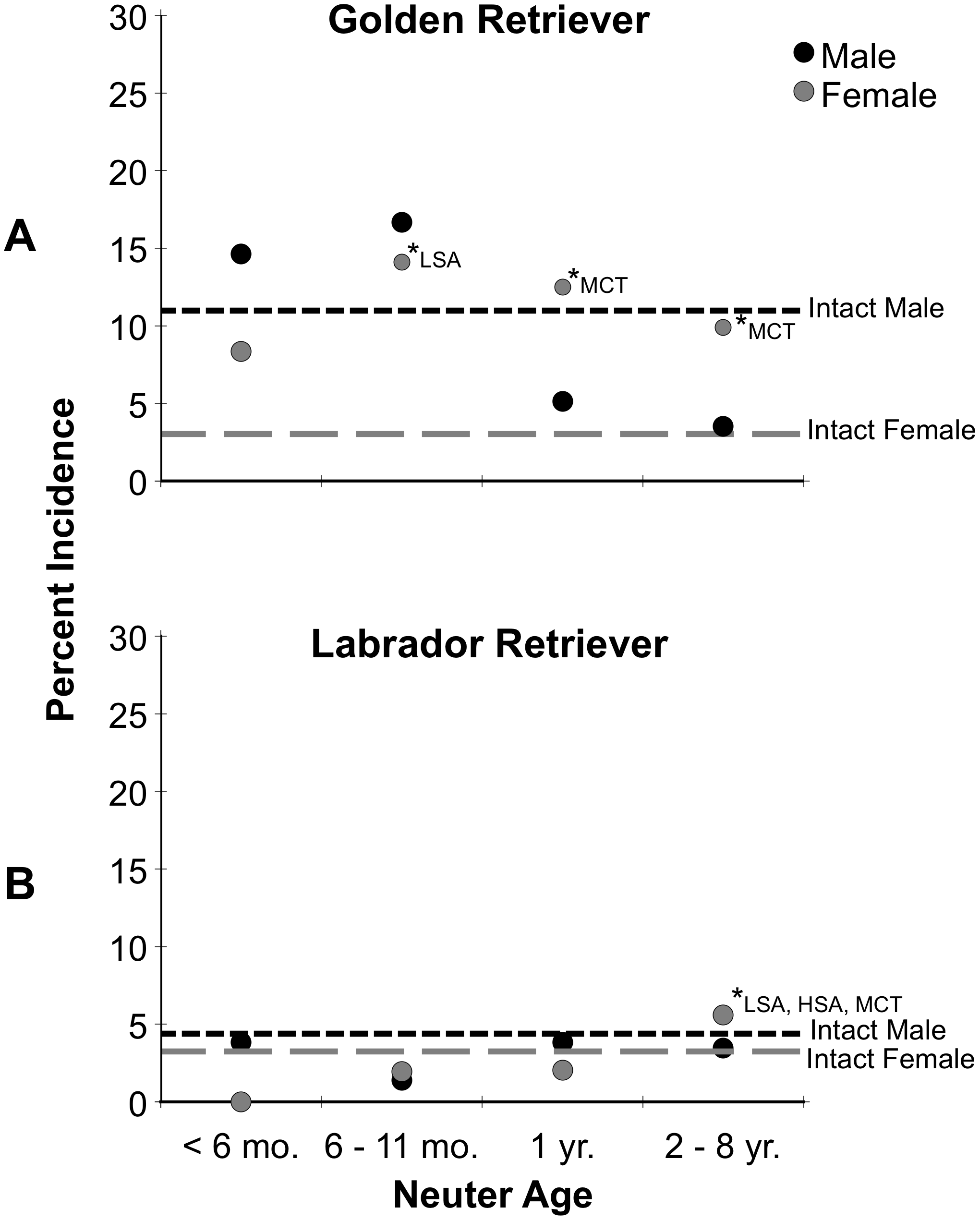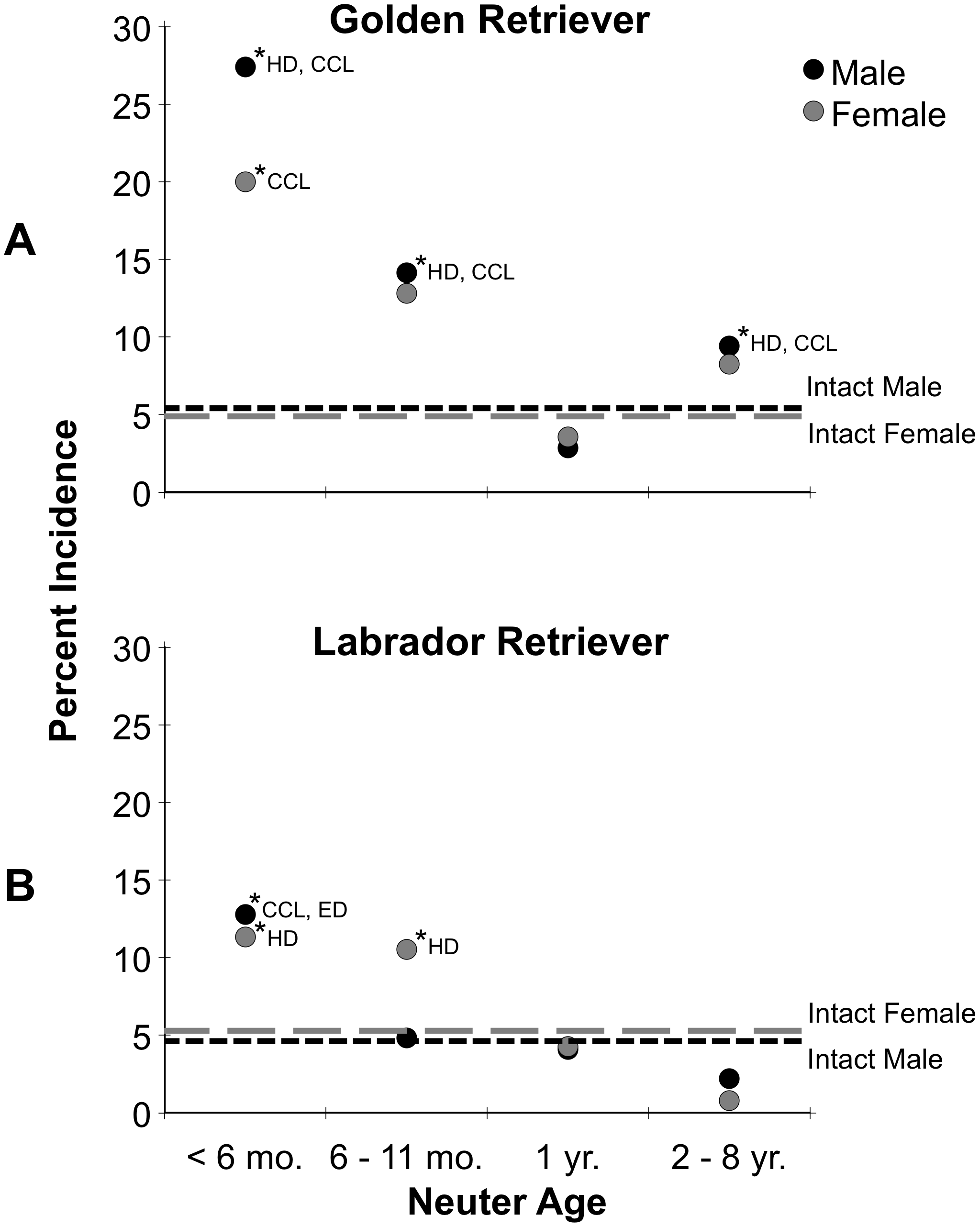One of the questions I’m always asked is when to have your golden retriever neutered or spayed. For so long, in the breeder community and beyond, the answer was as soon as possible. Mostly this answer stems from shelters trying to prevent overpopulation and euthanization. Recent studies suggest a different view because early neutering comes at a cost with disregard to the health of the puppy
First and foremost I am not a veterinarian. So I am not offering a medical perspective, rather my observations. A new study was done recently by UC Davis. The article by UC Davis is titled Neutering health effects more severe for golden retrievers than Labradors. The actual study results are found here: Long-Term Health Effects of Neutering Dogs
It is important to note that neutering and spaying effects bone growth and cancer rates.
Neutering prior to your dogs growth plates closing can cause complications that result in hip and elbow dysplasia. Growth plates begin to close around 6 months of age. Dogs neutered before 6 months of age have a 4 to 5 times chance of developing a form of dysplasia. As for cancer, any dog who is neutered or spayed has a higher chance of cancer compared to a dog that is intact. The affects of neutering males and cancer rates are not as evident as compared to females. With spayed females there is a 3 to 4 times increase of chance in developing some form of cancer.
For me though, reading the results isn’t just enough. When I looked at their charts, it showed that if a female is spayed prior to 6 months, she has a less increase of cancer rates compared to 6-12 months. It isn’t until 2 years of age, that the chance of cancer rates drops again nearing intact levels. However, if a female is spayed before 6 months then we know she will likely develop a form of dysplasia. We have to consider which one is worse, and quality of life is then important to consider.
So what age do we choose to neuter/spay, and at what cost?
If I had a male, I would wait till at least one year of age. That way we limit the risk of dysplasia which is it’s lowest, and cancer rates drop to the normal range comparing to an intact dog. Any sooner you would have higher cancer rates and dysplasia. For females it’s a bit more confusing. If it were me, I’d wait till two years before spaying a female if at all. At that age the risk of dysplasia is low, and cancer rates also return lower nearing intact levels. However, not everyone wants to deal with a female in heat. It’s not a cleanly process, especially if you have carpet. You will also have to deal with unwanted male dogs coming around and also risk an unwanted pregnancy. That can also be costly. For anyone other than breeders, waiting that long is probably not the likely or best scenario. In that case, I would suggest discussing with your vet to make a risk-benefit analysis as to when to spay your female. The closest cancer rates to intact female cancer rates, other than beyond 2 years, will be around 6 months. However, you have a higher risk for dysplasia at 6 months. For anyone still reading, I would seriously look at the charts from the study. I’ve shared them below so this way you can make an better informed decision with your veterinarian.
On a side note, part of the reason that English Cream Golden Retrievers have a lower rate of cancer, is the fact that they are from Europe. Many countries, like Norway, believe neutering is cruel to animals. Cancer rates are lower in part for that reason. It is important to also note that dysplasia can be debilitating. A longer life may possibly only be obtained by the lack in quality of life.
Lastly, one of my puppy parents sent me this video link. I’ve watched many videos by Dr. Becker, and this video discusses having your puppy neutered or spayed. It’s a long video, but she does explain some downfalls have having your pet fixed. It is a wholistic approach, but she does raise important points to consider.
[wp_ad_camp_1]



Thank you for good information. I have a 14 month old male golden and a 12 month old female. I have lost several goldens to cancer and have concerns about neuter and spaying. I am interested in sterilization without de sexing. A modified spay is sounding like a good choice. Are you doing this and vasecto my for males in your practice.
Sorry for the late reply. My computer was broken, so it was difficult to respond. I fully support vasectomies and modified spays. These surgeries leave the necessary sex organs intact, while making it impossible to get pregnant. There are a couple of downsides though by only doing a vasectomy in a male. Many people neuter their male because they like their males to be more submissive. This is done because the testosterone is decreased when taking the testicles away. If they remain intact, then the hormone levels are unchanged thus resulting in no temperament change. Also, there is a chance of testicular cancer at an older age if they are intact. However, that chance is still negligible by the increase of cancer rates by taking them out too soon. Hope that makes sense.
I have a 17 month old female golden, she has just finished her second heat. She is small fully grown I think. Trying to decide when to spay her. Hard decision to make with all the cancer in Goldens. any advice? Thank you, Marilyn
Since she’s already had her second heat, I would wait a few more months. The closer to the second year the better statistically. However, seeing on how she already had a second heat, I would attempt to do it before her 3rd heat. It appears your girl goes into heat every 6 months. Maybe do it at 5 months post second heat?
Thinking of neutering my 1 year + 9 months old, male golden retriever/golden doodle. Do you think it’s too early or should I wait until after he turns 2 years old?
I would wait the 3 more months. It’s not that much more of a wait, but it does decrease the chance of incidence of disease.
I have a 9 month old male golden retriever puppy. I was thinking of neutering him at 12 months, but read maybe 18 months-24 months is better? What would you do? We lost our 10 year old male golden to hemangiosarcoma and would like to do things differently this time around.
Personally I would wait. It may not prevent all types of cancer, but studies do show it decreases the incidences of them. If his temperament is good, I would wait in my opinion.
i have a 1 year old english golden retriever when should i spay her ( worried about health issues ) I also have a 3 year old golden that is neutered
I have a six month old female golden. The breeder is adamant that one must wait until after the first heat. My vet says the opposite. I use daycare twice a week and they will give me a little more time to decide but they’re putting the pressure on. Another resource recommended doing it between 7-8 months. I’m not sure what to do. I hate the idea of putting her at an increased risk of any disease. Intrigued by modified spay. Is it commonly available?
Thank you!
There are many factors to consider in your situation. First, not all vets stay up to date on latest research. Especially when that research is geared toward specific breeds. You would think they would, but from my experience with various vets, they do not. It is in your dogs best interest to wait. In your situation, the longer you don’t spay the more risk you have of her getting pregnant while in a daycare. Most vets don’t want to see unwanted pregnancies. So that may also be a part of the consideration to not spay on their end. They also make money off you spaying and the longer you wait the more risk you might go somewhere else. Lastly, you did mention modified spay. That might be your all around best option. It preserves the ovaries, and hormones stay intact. Which ideally should decrease chances of cancer and dysplasia. It’s not 100%, but if you find a good vet with experience, then you shouldn’t have a problem. I’m not a vet, so I can’t make medical advise, but if I were in your situation a modified spay might be your best bet. It could cost more for the procedure, even though it’s less invasive, but it might be worth the investment. I hope this helps.
Your post is very informative! I have a 10 week old Golden. I have read the recent study about possibility of cancer and hip dysplasia in goldens upon neutering them early. I am also worried about the thumping movement the males do , is that anywhere linked to being not neutered? Will that increase as the hormones are still produced? Like how they grab your leg or maybe their blanket and hit with it. Can you please advise how to reduce that.
I presume you meant humping, not thumping. Hormones will affect that. If it becomes a problem then you would have to way the cost benefit of what is more important and consult your vet. I’ve had a couple male goldens, and malamutes, and never once have I had an issue of them humping. Even the four males my in-laws have I’ve never seen them do it. I have seen some males do it, but not very often. I’ve also seen a couple male pups do it when little as a sign of dominance over other pups. Usually they grow out of it. Is yours already doing that at 10 weeks? In no way am I saying that it doesn’t happen, as it can. You would just have to weigh the risk. Even neutering may not necessarily mean it will stop them from doing that. Behavior correction is another option. You would have to discuss with a trainer if they know of methods that might work.
I have a 13 month old female Golden. She has not even had her first heat yet.
At this point I am just waiting. Things get complicated though as we live in Boston where we are close to Tufts (they are experienced in Ovary Sparing Spay)
Do you recommend this procedure after 2 yrs old or can it be done before? We are moving to Southwest Florida within the next 6 months and I don’t see any real experienced vets that do the OSS (according to Parsemus Foundation).
Ovary sparing would be far better than removing them all together too soon. I would definitely consider it.
I have a female golden who just turned one. I decided when she was younger after researching as best I could to wait until she was one year or after her first heat to be spayed. If mammary cancer is most unlikely if spayed before her first heat and her risk of dysplasia is lowest if spayed at approx one year, am I correct in concluding that if I spay her now before she goes into heat it is a “best of both worlds” situation?
I’m not a vet so I can’t say for certain. However, out of the hundreds of people who have come to me saying a dog they got from other breeders died of cancer, not once did I hear them say it was mammary cancer. I’ve heard of dozens of other cancers, but not one was mammary. Pancreatic, blood related cancers, sarcomas, and others I’ve seen are more often related to Goldens. I’m not saying that mammary cancer can’t happen, I’ve just not seen it as the normal occurrence. Not sure my comment will help you, but food for thought.